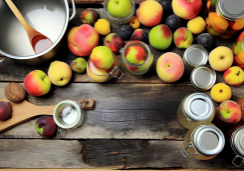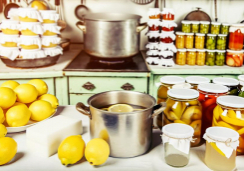What Makes Pizza Dough Irresistibly Perfect?
Just as Achilles had his heel, the perfect pizza dough has its vulnerabilities; it can be elusive, yet you're on a quest to master its craft.
You know it's not just about tossing flour and water together—there's an art to it, a subtle dance of ingredients and technique that can elevate your dough from merely good to the realm of the divine.
You've likely heard whispers of the importance of the right flour, the precise hydration level, and the delicate balance of yeast and salt, but you're still grasping for that quintessential texture and taste.
As you roll up your sleeves and dust off your apron, consider the nuances of kneading, the secrets of fermentation, and the alchemy of baking that can transform simple dough into a golden, chewy canvas that's just begging for toppings.
Isn't it time you discovered how these elements converge to create a dough that's not just good, but irresistible?
Choosing the Right Flour
Selecting the ideal flour is crucial for achieving the desired texture and structural integrity in your pizza dough. 00 flour stands out as a superior choice for those seeking a classic pizzeria crust. This finely milled flour gives your crust a distinct lightness and a crisp finish that's hard to replicate with other types.
When analyzing the properties of 00 flour, consider its gluten content. This flour strikes the perfect balance between elasticity and extensibility. While both bread flour and all-purpose flour are viable options, they have their drawbacks. Bread flour's higher gluten content can produce a tougher chew, while all-purpose flour may lack the necessary protein strength for a well-structured crust.
The protein in 00 flour is specifically calibrated for pizza dough, responding optimally to the kneading process. This interaction with warm water and active dry yeast during dough formation affects gluten development and ultimately the texture of your baked crust.
The Importance of Hydration
Understanding the role of 00 flour in your pizza dough's gluten structure, it's equally essential to consider how hydration levels will influence the dough's texture and baking characteristics. The water content in your homemade recipe is more than just an ingredient; it's a key variable that can make or break your quest for the perfect pizza dough.
- Hydration Ratio: The percentage of water to flour affects the dough's elasticity and extensibility.
- Gluten Development: Adequate hydration is crucial for gluten formation, which gives the dough strength and structure.
- Fermentation: Water interacts with yeast mixture, facilitating the fermentation that leads to a flavorful and airy crust.
- Baking Outcome: The amount of water in the dough can dictate the crispiness and chewiness of the best pizza crust.
When you knead the dough, hydration assists in aligning and strengthening the gluten networks. Too little water and your dough will be tough and difficult to shape; too much, and it can become sticky and unmanageable. Striking the right balance in pizza dough recipes is a technical art, with the goal of achieving a dough that's supple yet firm, capable of producing a crust that's both tender on the inside and crisp on the outside.
Kneading Techniques Explained
To achieve a pizza dough with the ideal texture, mastering the kneading technique is crucial as it directly influences gluten development and the overall quality of your crust. You must engage in a methodical process of folding, pressing, and stretching to make pizza dough that leads to a perfect pizza crust.
When you knead by hand, ensure you're on a well-floured surface to prevent sticking. Your movements should be deliberate and consistent, exerting adequate pressure to work the dough for about 10-15 minutes until it becomes smooth and elastic.
If you prefer using a stand mixer, it's best to attach the dough hook and let the machine work the dough at a medium speed. This typically takes less time, about 8-10 minutes, but be vigilant: over-kneading can be just as detrimental as under-kneading.
The dough should be slightly tacky and pass the windowpane test, indicating good gluten formation.
Optimal Fermentation Time
Having refined your kneading skills, it's now crucial to focus on the fermentation process, where time becomes your ally in enhancing the dough's flavor and texture. Optimal fermentation time profoundly affects your pizza dough's final outcome by allowing yeast and sugar to interact, thereby improving both taste and structure.
When you let it rise, the dough transforms as the yeast ferments the sugars, creating carbon dioxide and alcohol, which contribute to the dough's flavor and airy texture. For pizza dough to reach its full potential, here's what you need to keep in mind:
- Duration: Aim for a fermentation period of 24 to 48 hours for the most balanced flavor complexity.
- Temperature: Store the dough in a warm place or at room temperature to maintain steady yeast activity.
- Dough Development: Your dough should have doubled in size, indicating sufficient yeast action and gas production.
- Handling: After fermentation, divide the dough into balls, cover with plastic, and let it rise again before shaping.
Mastering the Baking Process
Ensuring your water temperature hovers between 110-115 degrees Fahrenheit is crucial for activating the yeast and achieving the ideal rise in your pizza dough. Precisely controlled water temperature facilitates optimal yeast proofing, which is the cornerstone of pizza crust recipes that boast airy and well-structured interiors.
Once your dough has risen, it's time to shape it on a lightly floured surface, ensuring even texture and preventing sticking. For a preheated pizza with a crispier crust, a pizza stone is your best ally. The porous nature of a stone absorbs moisture from the dough, contributing to a perfectly crisp bottom. However, if a stone isn't available, a baking sheet can suffice – just ensure it's preheated as well to mimic the stone's effects.
The oven temperature is another pivotal factor. It should be cranked up to the highest setting, usually between 450-500 degrees Fahrenheit, depending on your recipe and oven. This high heat shortens baking time and gives the pizza its characteristic char and crunch.
As you master the baking process, remember that the synergy between a preheated oven, either a pizza stone or a hot baking sheet, and the right oven temperature is what'll transport your pizza from homemade to artisanal status.
Frequently Asked Questions
What Is the Secret to Good Pizza Dough?
The secret to good pizza dough lies in meticulous flour selection, precise water temperature, adept kneading technique, controlled yeast fermentation, balanced salt content, judicious oil addition, ample resting time, and accommodating dough stretchability, all influenced by climate impact.
What Is the Best Consistency for Pizza Dough?
The best pizza dough consistency hinges on hydration ratio, flour type, and precise kneading time. Temperature control, resting periods, and the aging process enhance dough elasticity, fermentation stage, gluten development, and oil addition.
What Are the Characteristics of Good Pizza Dough?
You'll recognize good pizza dough by its elastic texture, proper hydration ratio, and adequate fermentation time. Optimal dough temperature, high-quality flour, active yeast, thorough gluten development, gentle dough handling, precise oil addition, and balanced salt content are crucial.
What Are the Mistakes in Pizza Dough?
You'll spoil your dough by under kneading, over proofing yeast, or using the wrong flour type. Ensure correct temperature, adequate hydration, and resting time for proper gluten development and avoid rapid fermentation or uneven rolling.
Conclusion
In conclusion, crafting perfect pizza dough involves several key steps.
First, it's important to meticulously select high-protein flour. This type of flour will give your dough the right structure and texture.
Next, adjusting hydration is crucial for achieving that tender, chewy texture. Finding the right balance of water to flour will make a significant difference in the final result.
Employing robust kneading methods is another essential factor. Kneading helps develop gluten, which gives the dough elasticity and strength.
Precise control over fermentation time is also crucial for flavor development. Allowing the dough to ferment for the right amount of time enhances its taste and texture.
Lastly, expertly navigating the baking process ensures a sublime crust. Paying attention to details such as water temperature and oven heat will help you achieve the perfect pizza crust.
In summary, perfection hinges on the details. It's your careful attention to each element, from flour selection to baking technique, that transforms simple ingredients into an irresistibly perfect pizza dough.










